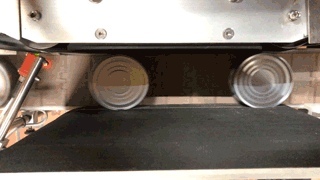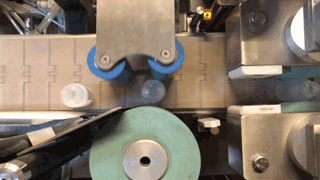Contents:
1) Types of Wraparound Labelling Machines
......a) In-Line Linear Wraparound Systems
......b) In-Line Three-Roller Wraparound Systems
......c) In-Line Combined & Modular Wraparound Systems
......d) Semi-Automatic Labelling Machines
2) Benefits of Automation
3) Summary
Types of Wraparound Labelling Machines
Across the world of self-adhesive labelling, there are many variants of labelling systems that are designed specifically to apply a label (partially or fully) around the circumference of a product. Manufacturers use a variety of names and terminology for the equipment involved but this article will focus primarily on the most common application systems, including linear wrap and three-roller wrap.

In-Line Linear Wraparound Systems
This system uses a label head to apply the leading edge of a label onto a product travelling along a conveyor belt. As the bottle continues to travel along the conveyor it will enter the wraparound system, which for linear wrap units (listed as 'after-roll' on our equipment) consists of one driven belt and one static backing pad. This system maintains linear bottle movement within the linear wrap unit and rotates the bottle to apply the label around the circumference.
The main benefit of this method is the high speed output which is enabled by the fact the bottle does not stop during application. The downside is that this style of equipment relies on the bottle/component quality to be very high; as the linear wrap unit is only holding the bottle on two sides, any tolerances (above accepted standards) within the manufactured product will cause the label to skew (or bubble/crease) on the product.
In-Line Three-Roller Wraparound Systems
This system uses a label head to apply the leading edge of a label onto a product whilst the bottle is held within the three-point contact wraparound system (also known as 'tri-roller' or 'prism' systems). It consists of two pneumatically controlled gating rollers, which move into the bottle to stop linear movement, and a single driven roller to rotate the bottle. This means that the product has to be stopped in place whilst the label is being applied and then released back onto the conveyor.
The main benefit of this system (and the reason for its creation) is for greater labelling accuracy on poorly manufactured product (including cheap glass), which is enabled by holding the product within three-points and stretching the label on. The three-roller system also eliminates label bubbling and/or creasing issues often found in linear wrap systems when labelling poor quality components. Due to the product being gated during application, the throughout speeds are sacrificed for a significant increase in accuracy. Premier Labellers have manufactured a dual-lane version of the three-roller wrap which allows users to experience the same high quality three-roller application whilst maintain high throughput speeds.
The three-roller system can also be used to apply two labels from a single label head (front and back) which are alternatively printed on a label reel (A/B/A/B/etc.) On top of this it has the capability to spot-orientate labels onto a specific place on the product. I.E. to over-label existing artwork, to place in orientation to a cap/trigger, or to place a body label in orientation to a lid label.
In-Line Combined & Modular Wraparound Systems
Some higher specification modular labelling machines offer both wraparound units on one machine, allowing production lines to switch between the high throughput linear wrap system and the high accuracy three-roller wrap system, depending on the component quality going onto the line. This allows for excellent flexibility for customers with a wide range of SKUs, as these systems also allow for any combination of front and back labelling. Our front and back range can be fitted with a foam-covered linear wraparound change-part which enables wraparound labelling on rectangular or square products.
Semi-Automatic Labelling Machines
These are entry-level machines which are generally marketed to start-up companies and business that require an upgrade from hand-applying without the investment of an in-line system. Semi-automatic systems often hold the product in a similar way to three-roller systems, but the semi-automatics are usually horizontal and manually operated by a 'feed' button or foot pedal; the product then has to be removed by hand and the process is repeated. It is an excellent introduction to the world of labelling for companies due to its low cost and ease of use, but the actual labelling process is very slow in comparison to in-line systems, which incurs a high labour cost for larger batches.
Benefits of Automation
The main benefit of automatic labelling machinery is that it can be placed in line with other production equipment which involves loading product in at one end, and removing complete product at the other. This saves the time and cost of have to manually move product from one piece of factory equipment to another. A basic bottle line setup might include: operator load/rotary table > filling machine > capping machine > labelling machine > operator unload/rotary table.
Once in place, lines can be adapted and expanded at any time and may include check-weight systems, metal detectors, pick and place robotics, label detection camera systems, etc. which all help to reduce manual processes, but all require investment. This is where semi-automatic machines are often a short-term stepping stone between hand-application and fully automatic labelling systems. Some business do not want to invest in in-house production at all and seek contract packing solutions for a third-party company to take on this responsibility on a cost per unit basis.
Summary
In-Line Linear Wraparound Systems
High speed.
Accuracy dependent on component quality.
Recommended for high production throughput on non-glass bottles.
Single partial or full wrap label only.
No spot-orientation compatibility.
In-Line Three-Roller Wraparound Systems
Medium speed.
Extremely high accuracy, even on poor components.
Recommended for any bottle type including cheap glass.
Single partial or full wrap label, or front and back alternate print labels.
Spot-orientation compatible.
In-Line Combined & Modular Wraparound Systems
Excellent flexibility for any production speeds.
Recommended for a wide range of SKUs.
Use of both systems for quality or quantity.
Any front & back, or wraparound label combination.
Spot-orientation compatible (three-roller system on one head only).
Semi-Automatic Labelling Machines
Very low speed.
Good value for money labelling accuracy.
Recommended for any bottle type.
Single partial or full wrap label (some models offer front and back alternate print labels).
Spot-orientation dependent on manufacturer specifications.
How Can We Help?
You can view our range of wraparound machines or our contract packing services, and if you need any help finding a solution please contact our team and we will be happy to help.
Disclaimer: Premier Labellers do not make any warranties about the completeness, reliability, and accuracy of this information. Any action you take on the information from this website is strictly at your own risk, and we will not be liable for any losses or damages in connection with the use of our website. No contractual relationship can be formed from the information in this article.







Comments